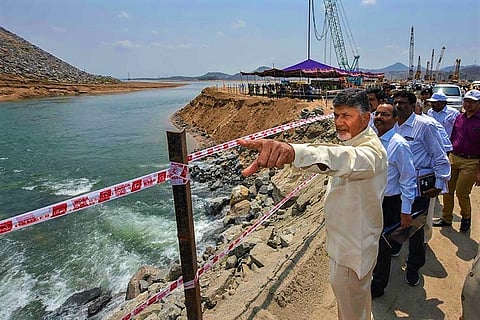

The election in 2014 saw the success of the Modi-Chandrababu team in the successor state of Andhra Pradesh with the twin planks – Polavaram irrigation project and capital in Amaravati.
The Polavaram project was marketed as the key for the rebuilding of the bifurcated agrarian state. The team captains promised to complete the project by 2018 and let the Godavari river, upon which the project is under execution, turn water-starved patches into lush green fields.
The impact of the poll promises was huge all over Andhra Pradesh, with 13 districts handing the TDP-BJP combine a windfall. Incidentally, the same election promise also saw the Congress return to power in 2004 after a decade-long political hibernation, replacing Chandrababu Naidu’s rule.
The promise, made by the late Congress leader YS Rajasekhar Reddy, to realise the five-decade-old dream at any cost, during his padayatra in the gruelling summer heat went viral. The distress situation in rural areas, marked by farmer suicides, recurring droughts and crop failures, lent much significance to Reddy’s promise then, accelerating the downfall of Naidu’s regime.
YSR laid the foundation stone for the project, which was named Indira Sagar, soon after his assuming charge as CM and completed most of the canal works during his first term. The project ran into rough weather after Reddy’s sudden death in a plane crash during his second term and the subsequent separate Telangana movement.
Post the elections, people in the state have been keen on the progress card of the state and the Centre, led by the TDP and the NDA governments respectively, vis-à-vis the Polavaram project for the last four years.
Equity in river water sharing
With its diverse terrains and climatic conditions and in the absence of major industries, Andhra Pradesh basically supports an agrarian economy. Drought-prone and backward Rayalaseema and Uttarandhra regions show the opposite side of the affluent coastal Andhra.
The existing major irrigation projects and reservoirs like Nagarjuna Sagar, Prakasam Barrage and Dhavaleswaram Barrage covered mostly the coastal tracts, making the Godavari and the Krishna deltas with 25 lakh acres of ayacut prosperous. The other two regions are left with a notorious track record of agrarian crisis. The river waters of the Godavari and the Krishna were harnessed by a few clusters of coastal areas through these projects.
The demand for equity in harnessing of river waters is gathering pace in Rayalaseema and Uttarandhra regions, triggering separatist movements off and on. The demand obviously becomes a vote-catcher for mainstream politics, which is out to cash in on public sentiment.
In keeping with the demand, the Polavaram project was designed to feed 2.7 lakh acres in East and West Godavari districts, supply water for drinking and industrial needs in Visakhapatnam, besides stabilising the Krishna delta. The present TDP government has decided to take the Godavari water up to the last point in the Uttarandhra region under the Uttarandhra Srujala Sravanthi scheme. The Krishna delta has come under serious threat in view of major dams in the upper reaches that hold up inflow from the Krishna.
Instant relief
Naidu in his latest innings aims to become AP’s waterman. Sensing inherent roadblocks in the Polavaram project, he found an instant remedy in the lift schemes across the Godavari. Subsequently, the TDP government built the Pattiseema and Purushothampatnam lift schemes as a source of temporary relief for the areas coming under the Polavaram project ayacut. By doing so, the Krishna delta was saved and Rayalaseema started drawing its share of water from the Krishna river through the Srisailam scheme.
Will Naidu complete his pet scheme before his own deadline? Peasant leaders and irrigation experts express doubts over its fate in light of the strained Centre-state relations as a result of the BJP-TDP break-up.
Akkineni Bhavani Prasad, a peasant leader representing the Krishna region, said it is unlikely that the Polavaram project will be completed before 2019. He cites the NDA government’s refusal to give its nod for the state government’s revised project estimates, comprising an R&R component of Rs 34,000 cr, and hiccups in the Centre’s reimbursement of funds incurred on the project by the state. Government agencies notified 227 villages inhabited by 1.97 lakh people as submergence areas.
AP’s irrigation minister Devideni Umamaheswara Rao recently told the media that the dam works could not be completed before relocating the submergence villages and paying the victims due compensation. It is also estimated that the government requires 90,000 acres of land for extension of land-to-land compensation to the project victims, 70% of them being tribals. The land rates are hovering over Rs 35-40 lakh per acre.
The Centre limits its financial assistance only to the irrigation component, excluding R&R, hydel power generation and drinking water supply components from the ambit of its assistance. “It’s nothing but betrayal,” fumes Naidu.
Blame game
Even as the deadline for the commissioning of the project is fast approaching, the estranged allies began a blame game, blaming each other for the delay. The TDP alleges lack of concern on the part of Prime Minister Narendra Modi for the welfare of the bifurcated state and for the promises due to be implemented by the Centre to correct the ‘wrong’ done to the latter.
In a bid to play up the regional sentiment, during his recent visit to East Godavari district Chandrababu had even threatened not to pay taxes to the Centre if funds for the Polavaram project were not received. It appears that Naidu is all out to turn the tide in his favour and gain maximum poll dividends by portraying Modi as the villain of the piece.